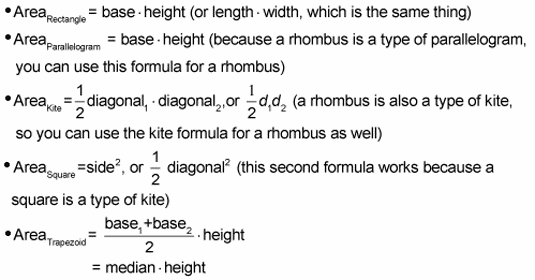There are five formulas that you can use to calculate the area of the seven special quadrilaterals. There are only five formulas because some of them do double duty — for example, you can calculate the area of a rhombus with the kite formula.
The quadrilateral area formulas are as follows:

Note: The median of a trapezoid is the segment that connects the midpoints of the legs. Its length equals the average of the lengths of the bases. You use this formula for all trapezoids, including isosceles trapezoids.
All five formulas on the list above are useful to know, but you can really get by with only three formulas. First, you don’t need a separate formula for the rectangle because a rectangle is a parallelogram, and thus you can use the parallelogram formula for a rectangle. (The rectangle formula is on the list, however, because it’s such a basic one — which you’ve known since at least middle school — and because it works a bit differently than the parallelogram formula.)
And second, because the square is a special type of four quadrilaterals — a parallelogram, a rectangle, a kite, and a rhombus — you don’t really need a special area formula for a square

dummies
Source:http://www.dummies.com/how-to/content/how-to-calculate-the-area-of-a-quadrilateral.html
No comments:
Post a Comment